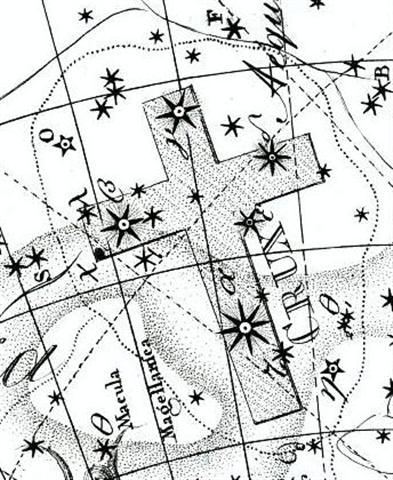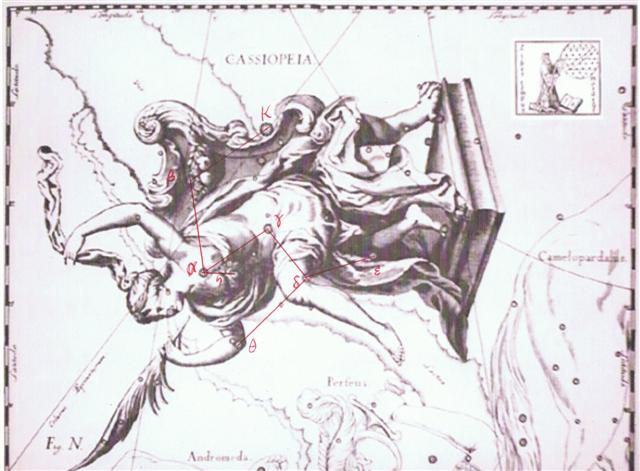Our attention should then move ahead to glyph number 27 + 347 = 26 + 348 = 374 = 2 * 187, where Metoro again said te heke. To identify the heliacal dates we have only to add 80 to the glyph numbers and to find the heliacal stars we should then reduce with 77. The corresponding nakshatra dates (and stars) are found by adding 183 to the heliacal dates (and stars):
There are 392 + 348 = 740 glyphs on the tablet and 740 / 2 = 370. Here (at *Ca14-7) we can see the same 'tattooing instrument' as in Ca1-2, but inverted. The Sun had reached Delta at the back side of Andromeda and close to the Full Moon was Porrima, followed by Mimosa. The Sun would then go past the Tail of the Seabeast (Deneb Kaitos, β Ceti) and on to Achird (740 / 2 days after hoea in Ca1-2). The Full Moon reached a spear place (vero), because 193 was approximately one more than 13 * 29½ / 2. And 193 was also equal to 370 - 177 (6 * 29½).
Porrima was γ in Virgo and Delta was δ in Andromeda: ... Hamiora Pio once spoke as follows to the writer: 'Friend! Let me tell of the offspring of Tangaroa-akiukiu, whose two daughters were Hine-raumati (the Summer Maid - personified form of summer) and Hine-takurua (the Winter Maid - personification of winter), both of whom where taken to wife by the sun ... Now, these women had different homes. Hine-takurua lived with her elder Tangaroa (a sea being - origin and personified form of fish). Her labours were connected with Tangaroa - that is, with fish. Hine-raumati dwelt on land, where she cultivated food products, and attended to the taking of game and forest products, all such things connected with Tane ...
Mimosa (β in the Southern Cross) was a name which meant the death was only a temporary stage in life. Mimosa was at the end of the Cross, as if marking a place of resurrection:
... The Sensitive plant (Mimosa pudica L.) is a creeping annual or perennial herb often grown for its curiosity value: the compound leaves fold inward and droop when touched, re-opening within minutes. Mimosa pudica is native to Brazil, but is now a pantropical weed. Other names given to this curious plant are Humble plant, TickleMe plant, Shame plant, Sleeping Grass, Prayer plant, Touch-me-not, Makahiya (Philippines, meaning 'shy'), Mori Vivi (West Indies), mate-loi (false death) (Tonga) ... In the evening the leaflets will fold together and the whole leaf droops downward. It then re-opens at sunrise ... Metoro gave the name rau hei for a type of glyph which was easy to associate to Mimosa:
As to Achird (η) this star was at the breast of Cassiopeia - reminding us of how Raven stole the skin and form of a newborn child and then was offered only mother's milk.
As a further argument should be mentioned my comments regarding Gb7-8: ... Allen does not mention Achird and he has no other name for η Cassiopeiae, but I guess the star could be connected with α Leonis, Regulus, once named Achir (Possessing Luminous Rays): Naturally sharing the character of its constellation as the Domicilium Solia, in Euphratean astronomy it was Gus-ba-ra, the Flame, or the Red Fire, of the House of the East; in Khorasmia, Achir, Possessing Luminous Rays; and throughout classical days the supposed cause of the summer's heat, a reputation that it shared with the Dog-star ...
|
||||||||||||||||||||||||||||||||||||||||||||||||||||||||||||||||||||||||||||||||||||||||||||||||||||||||||||||||||||||||||||||||||||||||||||||||||||||||||||||||||||||||||||||||||||||||||

















